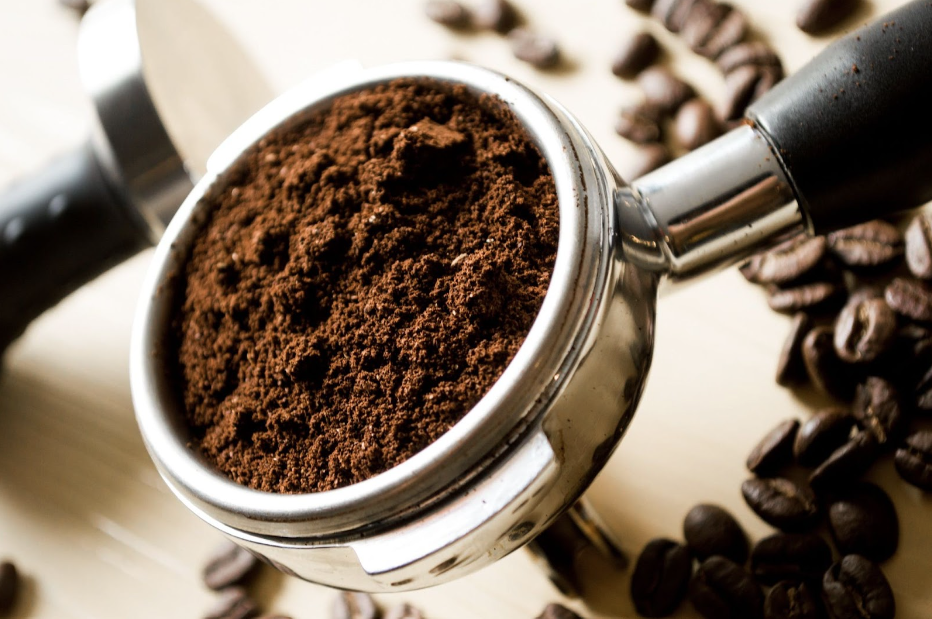It's hard to believe that coffee grounds, a byproduct of the coffee extraction process, can be repurposed as fertilizer for plants. Let's explore the miraculous benefits of coffee grounds for plants and discover the most innovative methods to utilize this resource, from the simplest approaches to advanced applications. So let's explore with EQUO the magical uses of coffee grounds for plants and the most creative methods to take advantage of this resource, from the simplest ways to advanced applications, and also set out some important notes when using coffee grounds in the process of caring for plants in the article below!
1. Uses of Coffee Grounds for Plants
Instead of being considered waste, coffee grounds have been recycled in various areas, including plant care. Here are some prominent uses of coffee grounds for plants:
1.1. Nutrient Supply
Coffee grounds contain organic matter and minerals such as nitrogen, phosphorus, and potassium. These are essential elements for the healthy growth of plants, promoting the flowering and fruiting processes. Therefore, coffee grounds are suitable as a natural fertilizer and beneficial for plants.
1.2. Soil Structure Enhancement
Beyond supporting plant growth, coffee grounds provide nutrient enrichment for the soil. This excellent organic source supplies energy to beneficial microorganisms in the soil. Using coffee grounds as fertilizer helps improve soil structure, enhancing water drainage and nutrient retention.

1.3. Soil Pollution Prevention
Coffee grounds can absorb and eliminate certain soil pollutants due to the presence of pollution and oxidation-resistant compounds. This contributes to easily purifying the environment for plant growth.
1.4. Pest Resistance
The antibacterial properties of coffee grounds can help plants resist harmful bacteria and fungi. With a small amount of nutrients provided to the plants, coffee grounds help reinforce their internal health, making them less susceptible to pest attacks. As coffee grounds decompose, they create an unfavorable environment for certain pests and bacteria, inhibiting their growth.
1.5. Repelling Pests
While humans enjoy the aroma of coffee, most pests do not. Based on this characteristic, coffee grounds repel pests from the growing area.
1.6. Encouraging Soil Vitality
Coffee grounds can encourage the vitality of beneficial microorganisms in the soil, creating a rich and balanced soil environment. Seeds will germinate and develop more effectively when the soil has sufficient nutrients.
1.7. Assisting Decomposition
Beyond promoting germination, coffee grounds also aid in decomposition. Due to their natural decomposition ability, coffee grounds reduce organic waste. When incorporated into the soil, coffee grounds help regenerate the soil, improving its quality over time.
By harnessing these advantages, coffee grounds not only become a natural fertilizer but also serve as a valuable tool in maintaining the health of plants and preserving the environment, making them increasingly lush and green.
>> Read More:
- Coffee Straws Made Of Coffee Grounds: A New Eco-Friendly Choice
- Easy Homemade Composting: Solution For Your Organic Waste
- 5 Best Eco Compostable Straws Made From Plants
- 7 Best Types of Biodegradable Straws: Eco Friendly Compostable
- Compostable Straws: Plant-Based Straws Versus Paper Straws
2. Ways to Use Coffee Grounds as Fertilizer
Corresponding to the mentioned benefits, coffee grounds can be used in various creative and flexible ways as fertilizer. Here are some suggestions for you:
2.1. Mix coffee grounds with soil
You can either spread coffee grounds directly around the base of plants or mix them into the soil. Coffee grounds help improve soil structure, retain water, and provide nutrients to plants evenly. Though simple, this is an effective way to fertilize plants with coffee grounds.

2.2. Compost coffee grounds
If the above method seems mundane, you can try composting coffee grounds to create a compost mix. The result of this process is a type of mixed fertilizer. The only two components needed are coffee grounds and manure, such as cow dung, chicken manure, or other organic fertilizers. After successful composting, using this mix will enhance the nutrients for plants.
2.3. Dry fertilizer from coffee grounds
People also use the drying method to create fertilizer from coffee grounds. Coffee grounds can be processed into dry fertilizer by letting them naturally air dry or using a low-temperature oven. This type of fertilizer can be easily stored and used as needed, preserving many essential nutrients. However, it's important to store dry fertilizer from coffee grounds in a dry environment, avoiding direct sunlight and high temperatures.
2.4. Liquid fertilizer from coffee grounds
You can apply a simpler method and still achieve similar results with liquid fertilizer from coffee grounds. Just soaking coffee grounds in water creates a natural fertilizer solution. With its liquid nature, this fertilizer can easily be absorbed through both the leaves and roots of plants, providing nourishment.
With these four methods, regardless of the chosen approach, as long as you follow the instructions correctly, you will reap the "sweet fruit" of healthy plant growth. Moreover, you are contributing to reducing the amount of organic waste and chemical fertilizers globally.
3. Considerations When Using Coffee Grounds for Plants
While it's undeniable that coffee grounds possess excellent regenerative and nutrient-providing qualities, these strengths can become a double-edged sword if not used correctly. Therefore, when using coffee grounds as fertilizer for plants, it's essential to pay attention to the following six points:
3.1. Quantity of Coffee Grounds
Excessive coffee grounds can lead to soil compaction and increase the acidity level in the soil, posing a risk to plant development. On the contrary, insufficient use can result in nutrient deficiencies for plants. Therefore, determine the quantity of coffee grounds based on the type of plant and soil you are caring for and adhere to the recommended dosage.

3.2. Proper Mixing
Plant care requires precision, much like brewing a perfect cup of coffee. When using coffee grounds as a component in potting mix or fertilizer, ensure thorough mixing with other components if you want the plant to receive a uniform nutrient supply.

3.3. Dealing with Mold
While coffee grounds are known to protect plants from pests, diseases, and insects, this function can be nullified if the grounds develop mold. This resource provides an ideal environment for mold growth. To prevent this, use coffee grounds that have been properly dried and stored.
3.4. Regular Inspection
Frequently check the condition of the plants to ensure there are no signs of health issues arising from the use of coffee grounds. If any issues arise, timely remedial measures should be taken.
3.5. Consider Plant Varieties
Different plants have varying nutritional needs. Ensure you have a clear understanding of the specific plants you are caring for to adjust the amount of coffee grounds accordingly, avoiding regrettable situations.
By paying attention to these six factors, using coffee grounds is sure to yield optimal results without causing negative impacts on the health of plants or the environment.
4. Other Uses of Coffee Grounds
Coffee grounds are not just valuable as fertilizer for plants; they also have various practical applications in daily life. Let's explore the prominent uses of coffee grounds with EQUO:
>> Read more:
15+ Uses of Coffee Grounds: From Beauty to Lifestyle and Environment
4.1. Commercial Products from Coffee Grounds
Straws: Coffee straws are an environmentally friendly alternative, completely replacing plastic straws. Sturdy and durable, they don't break when immersed in water and fully decompose in the natural environment, enriching the soil as a biodegradable fertilizer. Made from 100% natural materials, these straws are safe for human health.
>> https://shopequo.com/products/coffee-straws

Utensil Set: Single-use eating utensils like knives, spoons, and forks are no longer unfamiliar and are popular for their convenience. However, the substantial amount of plastic waste generated from their daily use is considerable. A utensil set made from coffee grounds is the perfect eco-friendly alternative, enhancing the taste and convenience of meals while promoting sustainability.
>> https://shopequo.com/products/equo-coffee-utensils-knives-spoons-forks-pack-of-30-10-each

-
Shoes: Using coffee grounds instead of leather or synthetic materials, these shoes showcase creativity in design and reduce pressure on natural resources. This product is not only fashionable but also environmentally friendly.
-
Face Mask: Made from coffee grounds, this face mask is not only eco-friendly but also effectively combats dust and pollution. This innovation contributes to reducing unnecessary plastic waste.
-
Cup: A creative and sustainable cup made from coffee grounds, maintaining temperature and providing a unique coffee-drinking experience.
4.1. Odor Eliminator
In addition to emitting a pleasant aroma, coffee grounds are effective at absorbing odors. Therefore, they serve as an efficient product for eliminating unpleasant smells in refrigerators, shoes, or other small spaces.
4.2. Decorative Element
Few would think that the unassuming and hard-to-mold coffee grounds could be used for decoration. With their characteristic brown color and aroma, coffee grounds are employed to create high-traction flooring surfaces, often found in gardens and outdoor spaces. Additionally, coffee grounds can be used as a decorative wall material. By applying a layer of coffee grounds to the wall and adhering them with glue or bonding agents, you can create various effects and unique, cozy spaces close to nature.
4.3. Culinary Uses
Dried coffee grounds can be used as a spice for food, especially in baking or making sauces. While applicable to both savory and sweet dishes, the primary function of coffee grounds is to enhance the distinctive flavor and add a unique taste to the food, providing a memorable experience for the consumer.
4.4. Exfoliant for Skin
When combined with coconut oil or fresh milk, coffee grounds can become a natural exfoliant, promoting soft and radiant skin. Moreover, the coffee aroma lingers on the body after this process, providing a pleasant sensation for the user.

4.5. Natural Dye
Coffee grounds can also be used as a natural fabric dye. With a dyeing time of just a few hours, you can achieve a unique and natural brown color for the fabric with basic steps and simple tools. Note that the final color may vary depending on the type of fabric, soaking time, and the amount of coffee grounds used.
In summary, coffee grounds are not just a companion in plant care but also the right hand of every household with numerous useful applications. Starting as a byproduct of making a cup of coffee, through the recycling process, coffee grounds have been elevated to become a valuable resource with many applications in both plant care and general life. The innovation in reusing coffee grounds has created a potential resource for minimizing waste and promoting sustainability in production and consumption. Therefore, don't hastily discard coffee grounds; instead, maximize their use as EQUO suggests to bring economic value to yourself and contribute to community well-being for society!


